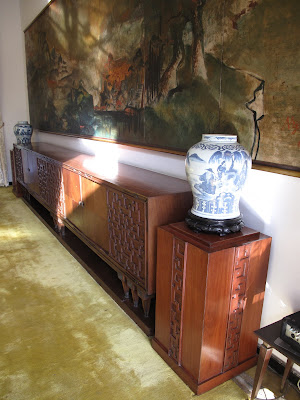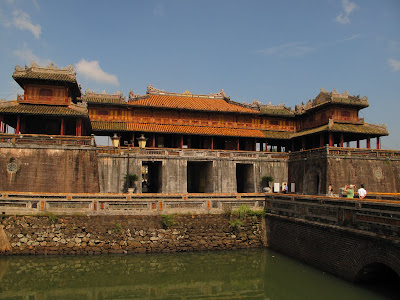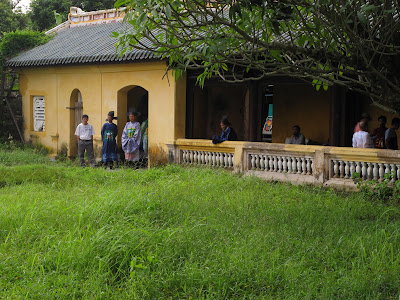 I consider myself a lover of fast-paced cities and a pretty savvy urban dweller. New York is my home; I love Tokyo's futuristic complexity; even the vastness of London can be exciting when the weather isn't totally gross. Nothing, and I mean nothing, could prepare me for the totally frenetic, youthful viberance of Saigon. There is a throbbing energy, packed night markets, throngs of teenagers everywhere, and insane traffic weaving through it all. I had heard that compared to the exotic crumbling charm of Hanoi, Saigon seemed more flashy but with less character and culture. I did not find that to be the case at all and hope that on my next trip to Vietnam I get to spend more time in this fascinating city.
I consider myself a lover of fast-paced cities and a pretty savvy urban dweller. New York is my home; I love Tokyo's futuristic complexity; even the vastness of London can be exciting when the weather isn't totally gross. Nothing, and I mean nothing, could prepare me for the totally frenetic, youthful viberance of Saigon. There is a throbbing energy, packed night markets, throngs of teenagers everywhere, and insane traffic weaving through it all. I had heard that compared to the exotic crumbling charm of Hanoi, Saigon seemed more flashy but with less character and culture. I did not find that to be the case at all and hope that on my next trip to Vietnam I get to spend more time in this fascinating city.
One of the highlights was the food. My husband was sick and sadly missed all 36 hours we had in Saigon trying to recover and gear up for treking temples in the heat of Cambodia (more on that soon). This meant I was on my own, with the (absolutely necessary) help of my sassy and fun guide Chau, to discover Saigon's food scene. She and I ate at two ends of the spectrum: a trendy, organic, locally sourced neo-Vietnamese eatery as well as a hot, smelly packed night market bazaar stand. Both were outstanding. I don't even know all of what I ate, but here are some pictures of it!





 Besides the food, the War Remnants Museum was an emotionally difficult but totally required highlight. My other favorite was the former Presidential Palace, now known as the Reunification Palace. This weird 1960's relic was designed by Vietnamese architect Ngo Viet Thu for the South Vietnamese president Ngo Dinh Diem. It stands where the original French colonial Norodom Palace once stood. That residence was home to the French colonial governors of Indochina and then the South Vietnamese president until it was bombed by Diem's own airforce in a US backed assassination attempt in 1962. The US had of course propped up Diem's corrupt regime during the Vietnam war until he became a liability and we decided to throw our hat in the ring to help get rid of him. The assassination attempt did not work (a later one did) and Diem ordered the construction of this new modern residence in place of the Norodom Palace.
Besides the food, the War Remnants Museum was an emotionally difficult but totally required highlight. My other favorite was the former Presidential Palace, now known as the Reunification Palace. This weird 1960's relic was designed by Vietnamese architect Ngo Viet Thu for the South Vietnamese president Ngo Dinh Diem. It stands where the original French colonial Norodom Palace once stood. That residence was home to the French colonial governors of Indochina and then the South Vietnamese president until it was bombed by Diem's own airforce in a US backed assassination attempt in 1962. The US had of course propped up Diem's corrupt regime during the Vietnam war until he became a liability and we decided to throw our hat in the ring to help get rid of him. The assassination attempt did not work (a later one did) and Diem ordered the construction of this new modern residence in place of the Norodom Palace. When South Vietnam fell in 1975, the image of the Northern Vietnamese tanks crashing through the gates of the compound signaled to the world that the US had lost the war and Vietnam would be one communist country, hence the new name, Reunification Palace.
When South Vietnam fell in 1975, the image of the Northern Vietnamese tanks crashing through the gates of the compound signaled to the world that the US had lost the war and Vietnam would be one communist country, hence the new name, Reunification Palace.  Inexplicably, the new govenment left nearly everything in its place as a museum (of victory, I suppose?). All the furniture, draperies, wall treatments, etc. are still there, and the building is a strange relic of swinging 60's meets Vietnamese design. There is actually no air conditioning, but the structure remains cool from open windows and cross ventilation worked throughout the spaces.
Inexplicably, the new govenment left nearly everything in its place as a museum (of victory, I suppose?). All the furniture, draperies, wall treatments, etc. are still there, and the building is a strange relic of swinging 60's meets Vietnamese design. There is actually no air conditioning, but the structure remains cool from open windows and cross ventilation worked throughout the spaces.








 My favorite room was the "signatory room," covered in lacquered panels and featuring these bizzare but fantastic James Mont style seating pieces and case pieces.
My favorite room was the "signatory room," covered in lacquered panels and featuring these bizzare but fantastic James Mont style seating pieces and case pieces.





 Three hours drive south of Hue is the old port city of Hoi An. This architectural gem of a town was an important sea trading port from the 15th to the 19th centuries. Chinese, Japanese, Portugese, Indian, Javanese, British and American ships all stopped in Hoi An, or Faifoo as it was called, and many merchants stayed permenently. Because of these many outside influences, and because Hoi An remained a "non-strategic" location for most of the 20th century, the town is still filled with wonderful old multi-cultural residential and commercial buildings. Since UNESCO declared it a World Heritage Site in the 1990's, cars are banned from its streets and the center of town has taken on a very tourist-centric edge. All the visitors and fusion restaurants don't take away from the beauty, especially on an early morning stroll before the Venice-in-summer-like hoardes descend.
Three hours drive south of Hue is the old port city of Hoi An. This architectural gem of a town was an important sea trading port from the 15th to the 19th centuries. Chinese, Japanese, Portugese, Indian, Javanese, British and American ships all stopped in Hoi An, or Faifoo as it was called, and many merchants stayed permenently. Because of these many outside influences, and because Hoi An remained a "non-strategic" location for most of the 20th century, the town is still filled with wonderful old multi-cultural residential and commercial buildings. Since UNESCO declared it a World Heritage Site in the 1990's, cars are banned from its streets and the center of town has taken on a very tourist-centric edge. All the visitors and fusion restaurants don't take away from the beauty, especially on an early morning stroll before the Venice-in-summer-like hoardes descend.



















 The Perfume River, home of the delicious river snail.
The Perfume River, home of the delicious river snail.
 When the Nguyens took power at the beginning of the 19th century, ending years of civil strife, rebellion, and a battle for power with the Trinh lords based in Hanoi, they built an impressive imperial citadel in Hue to represent their new status. The design was influenced by the Forbidden City in Beijing as well as French military architecture and took years of work by local artisians and craftspeople to complete. Although the world was entering the modern era, Nguyen Vietnam (with influence from France and Qing China) was a grand and glorious court of splendor that harked back to earlier times.
When the Nguyens took power at the beginning of the 19th century, ending years of civil strife, rebellion, and a battle for power with the Trinh lords based in Hanoi, they built an impressive imperial citadel in Hue to represent their new status. The design was influenced by the Forbidden City in Beijing as well as French military architecture and took years of work by local artisians and craftspeople to complete. Although the world was entering the modern era, Nguyen Vietnam (with influence from France and Qing China) was a grand and glorious court of splendor that harked back to earlier times. Unfortunately Hue, like much of central Vietnam, was right at the epicenter of both the French Indochina war and the second Indochina war with the United States. The imperial city was mostly destroyed by Vietnamese mortor shells and US napalm when Hue was occupied by North Vietnamese forces during the Tet Offensive.
Unfortunately Hue, like much of central Vietnam, was right at the epicenter of both the French Indochina war and the second Indochina war with the United States. The imperial city was mostly destroyed by Vietnamese mortor shells and US napalm when Hue was occupied by North Vietnamese forces during the Tet Offensive.  A model shows the layout and proportions of the imperial city. 80% of these buildings were destroyed during the war.
A model shows the layout and proportions of the imperial city. 80% of these buildings were destroyed during the war.







 A Vietnamese period piece was being shot on the grounds as we walked around.
A Vietnamese period piece was being shot on the grounds as we walked around.
 Just outside town is the Thien Mu Pagoda. Originally founded in 1601 when Hue was merely a provincial town, the current pagoda and nearby temple were built in 1844 by the Nguyen emperor Theiu Tri. After the partition of Vietnam (post-French Indochina war) Thien Mu became a nexus of political opposition against the policies of anti-Buddhist, pro-Catholic, US-backed South Vietnamese president, Ngo Dinh Diem. It was from this temple in 1963 that a monk named Thich Quang Duc left for Saigon where he set himself on fire and burned himself to death in protest. Images of his self-immolation were spread around the world.
Just outside town is the Thien Mu Pagoda. Originally founded in 1601 when Hue was merely a provincial town, the current pagoda and nearby temple were built in 1844 by the Nguyen emperor Theiu Tri. After the partition of Vietnam (post-French Indochina war) Thien Mu became a nexus of political opposition against the policies of anti-Buddhist, pro-Catholic, US-backed South Vietnamese president, Ngo Dinh Diem. It was from this temple in 1963 that a monk named Thich Quang Duc left for Saigon where he set himself on fire and burned himself to death in protest. Images of his self-immolation were spread around the world.